IN THIS ISSUE
- Amazing bees
- Terrapin research
- Season in the sandhills
- Cool quail, hot message
- Answers about black fox squirrels
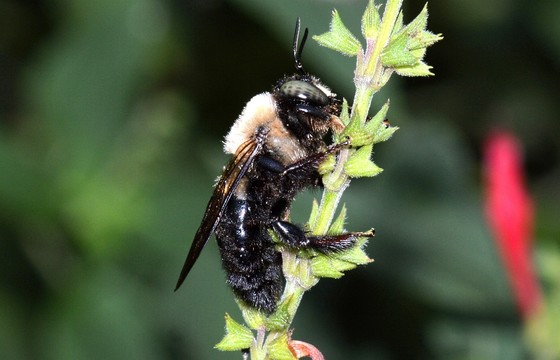 Bumblebee at work (Terry W. Johnson)
By TERRY W. JOHNSON
Until I retired, I never spent much time watching bumblebees. I guess that like most folks I took them for granted. But with more time on my hands now, the flight of a bumblebee never fails to grab my attention.
My observations of bumblebees visiting flowers in my backyard, coupled with learning more about them, has transformed me into a great admirer of these large, hairy insects.
Not only do they work harder than most other pollinators, they are extremely efficient, pack a metabolism rate that puts hummingbirds to shame, carry loads that defy their short wings and communicate with fellow bees in amazing ways. …
Read the rest of Terry’s column for intriguing insights into bumblebees.
Terry W. Johnson is a retired DNR program manager and executive director of TERN, the Wildlife Conservation Section’s friends group. Read more columns, Terry’s Backyard Wildlife Connection blog and his book “A Journey of Discovery: Monroe County Outdoors.” (Permission is required to reprint this column.)
DID YOU KNOW
Of the 49 bumblebee species native to North America, 17 live in Georgia.
Top
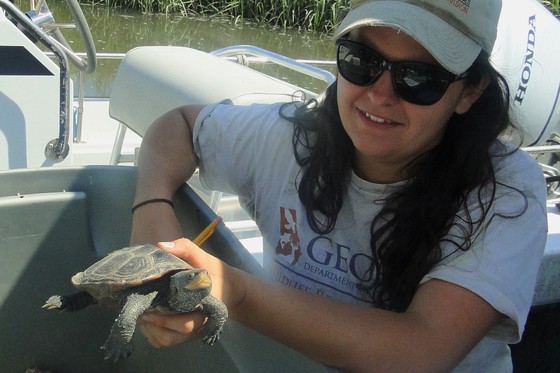 DNR's Ashley Raybould shows a terrapin caught during the April surveys. (Rick Lavender/DNR)
“Look at those eyes!”
It’s a sun-spangled morning on a Georgia tidal creek and the green-hued eyes of a diamondback terrapin have caught Ashley Raybould’s.
"I’ve seen the really blue ones but not the turquoise ones,” the DNR wildlife technician says, turning the turtle so others on the survey boat can see.
Diamondback terrapins aren’t new to awww. They are jewels in the marsh mud, with speckled skin, mouths that can look like they’re smeared with lipstick and googly eyes that sometimes glisten as if dusted with glitter.
But these hand-sized turtles found in salt marshes and estuaries from Cape Cod on the Atlantic to Texas on the Gulf of Mexico also share a darker feature: Declines in diamondback populations have been reported across their range. DNR has been sampling tidal creeks this spring to check the species’ status in Georgia.
“We want to assess whether their population is increasing, stable or decreasing,” said Mark Dodd, a senior biologist with the agency’s Wildlife Conservation Section.
More than a century ago, when terrapin soup was a gourmet dish, no one was checking. …
Read more about efforts to conserve diamondback terrapins.
Watch the survey crew return a terrapin to a tidal creek.
DIAMONDBACK TERRAPINS AT A GLANCE

- Possibly named for the diamond-like rings on their carapace scutes.
- Live in brackish and saltwater estuarine habitats.
- Found on the Atlantic and Gulf coasts from Massachusetts to Texas.
- Eat a variety of invertebrates, including fiddler crabs and periwinkle snails, as well as carrion.
- Mate in April and May; females lay eggs in late spring on sandy, upland areas by salt marshes.
- Exhibit high site fidelity: Adults often spend their entire life in a single tidal creek.
HOW TO HELP
Top
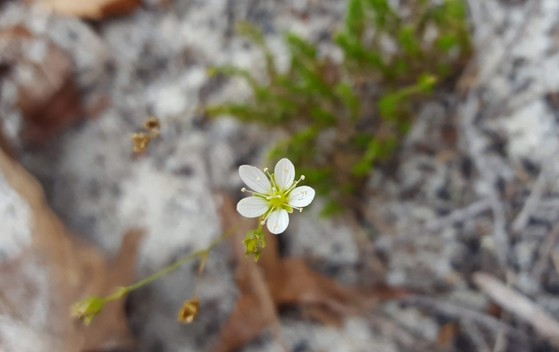 Pine barren stitchwort (Melanie Flood/DNR)
By MORGAN BETTCHER and MELANIE FLOOD
Before we joined DNR, neither of us had ever seen a sandhill.
Sure, everyone sees dunes when visiting the beach. But hills of sand in middle Georgia?
Last fall, we visited sandhills across the state, from the Fall Line near Columbus to the coast. We were, for that season, the Wildlife Conservation Section’s vegetation monitoring team, working as part of the Multistate Sandhills/Upland Longleaf Ecological Restoration Project.
We learned and saw so much, all of it connected to an ecosystem that is amazingly rich in life and in urgent need of restoration and conservation. …
Follow Melanie and Morgan on their field season in the sandhills.
Top
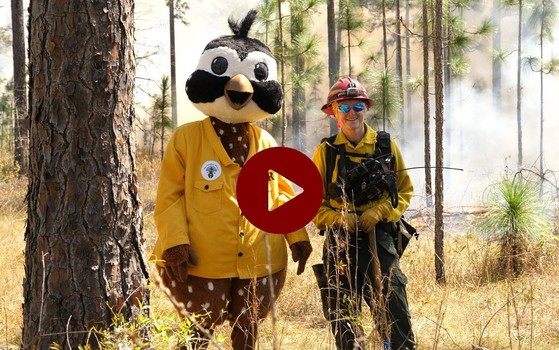 Burner Bob with DNR's Shan Cammack (Heidi Ferguson/DNR)
A Nomex-wearing bobwhite is singing the praises of prescribed fire.
Burner Bob has been making appearances, shooting videos and even rubbing elbows – and wings – with the U.S. Forest Service’s Smokey Bear.
The prescribed fire mascot created by Georgia longleaf pine advocate Reese Thompson and adopted as The Longleaf Alliance’s “spokesquail” is helping raise awareness of prescribed fire’s vital role in creating and restoring habitat for many animal and plant species. Northern bobwhites, of course, are one of them.
Already sporting a Facebook page, the big bird recently finished his first video (co-starring DNR’s Shan Cammack) and carried the flame for Rx fire at the Project Learning Tree International Coordinators’ Conference this month, where he teamed with Smokey for photo ops.
His next stop: the North Georgia Prescribed Fire Council meeting, June 6 in Jasper.
Top
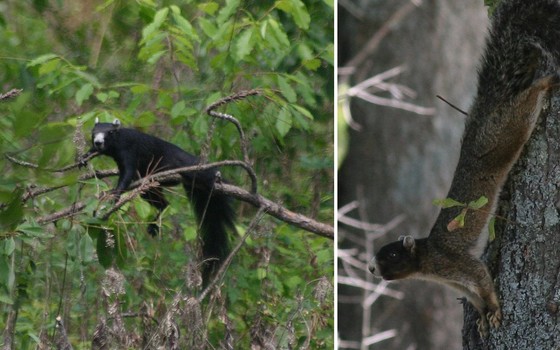 Left: a black fox squirrel; right: the gray-phase with black mask (Steve Kyles)
Hunter Candler Broom said he sees black fox squirrels on property he deer hunts near Covington. His question: How common are they?
Actually, they're pretty common, says senior wildlife biologist Katrina Morris of the Wildlife Conservation Section.
“The most common fox squirrel coloration in the Southeast is the gray phase with the black mask,” she adds. “However, the prevalence of solid black fox squirrels is pretty high. South Carolina residents reported that about one-quarter of the fox squirrels they’d seen were black.
“We don’t have any numbers for Georgia but I would imagine it would be similar. But, people tend to notice the black squirrels more, so those numbers from South Carolina might be a little high. I have seen black squirrels in the Covington area and I think that phase is not uncommon there.
“In general, fox squirrels are less common than they once were, but their coloration is really variable. I am always happy when I see anything other than a gray squirrel!”
Got a wildlife question? Send it our way.
Top
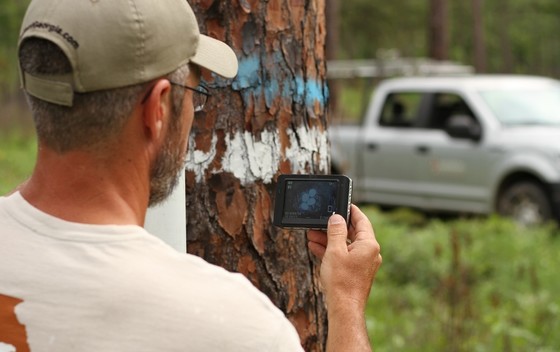 Joe Burnam uses a nest cam to check the eggs in a River Creek nest (Rick Lavender/DNR)
Rare birds back at River Creek? You bet! DNR wildlife biologist Joe Burnam has documented three red-cockaded woodpecker nests with eggs at River Creek, the Rolf and Alexandra Kauka Wildlife Management Area, the first since the endangered species was reintroduced to the Thomasville WMA in 2017. (Unfortunately, the first nest was lost to predation this week.)
More nest news: In a project tracking prothonotary warblers, at least three of the bright-colored neotropical migrants banded by DNR last summer have returned to the same breeding areas at River Creek and Alapaha River WMAs. Meanwhile, on the coast staff are monitoring about 120 pairs of American oystercatchers, and working to keep people and their pets away from all beach-nesting birds.
What can you do to help beach-nesting birds when visiting the beach?
- Avoid posted nesting sites.
- Walk below the high-tide line.
- Watch beach birds only from a distance.
- Back away from any nesting birds you accidentally disturb.
The Georgia Plant Conservation Alliance was on the awards podium again this week. The National Association of Environmental Professionals, meeting in Baltimore, honored the 55-member network committed to preserving Georgia’s rare flora with an honorable mention in environmental excellence.
Prescribed fire will be center stage at Chattahoochee Technical College’s campus in Jasper June 6 for the Georgia Prescribed Fire Council’s first north Georgia meeting. Topics will vary from fire effects on eastern oak ecosystems to connections between controlled burns and air quality. Register by May 31.
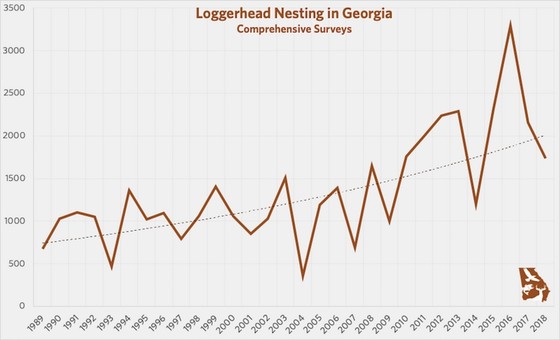 2019’s first loggerhead sea turtle nest was found on Cumberland Island April 26. The Georgia Sea Turtle Cooperative has since marked nearly 500 nests on the coast, fueling hope for a strong year for these marine reptiles on the rebound. Beach nesting updates.
Eight more manatees are sporting GPS transmitters after being caught last month, tagged and given a health checkup before being released in Cumberland Sound for a study tracking their movements. All told, Clearwater Marine Aquarium Research Institute and DNR are now following 11 manatees.
When it comes to native plant diversity, Georgia has edged Florida as the Southeast’s leader, according to a recent check of a database kept by Alan Weakley of the North Carolina Botanical Garden. Georgia’s count is up to 3,844 vascular and non-vascular species, writes DNR’s Dr. Mincy Moffett Jr.
Recent rare plant finds by DNR botanists in northwest Georgia include new records for sweet white trillium and limestone adder's-tongue, and confirmation of Tradescantia ernestiana, a spiderwort long suspected but never “concretely” documented in Georgia.
A plant identification workshop near Brunswick last month helped about 20 native plant enthusiasts up their game in using plant ID tools. DNR Wildlife Conservation Section staff teamed with the Longleaf Alliance to lead the lectures and field trips at Altama Plantation Wildlife Management Area.
Top
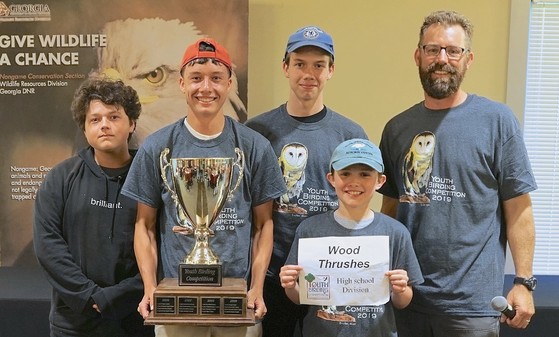 Members of The Wood Thrushes with competition coordinator Tim Keyes (Chris May)
In this year's Youth Birding Competition, 27 teams spent 24 hours in late April scouring the state for birds, with the Wood Thrushes notching a record 171 species as they won the title for the second straight year. Participants also raised nearly $4,000 for conservation, a voluntary part of the competition. Event photos.
Thirteen youth have been named statewide winners in the Give Wildlife a Chance Poster Contest held by DNR and the State Botanical Garden of Georgia. More than 1,300 kindergarten through fifth-grade students turned their ideas about this year’s “Pollinator Power” theme into art. See the top posters.
Want to educate yourself on Georgia wildlife? Check out DNR’s ed-focused playlist on YouTube, where selections range from “Songbird Nesting” to Georgia Outdoors’ “Raptors in Flight.”
Being bearwise means knowing how to cope with black bears. One basic is securing food, garbage and recycling, because when bears have access to people-provided food, they will take advantage of them, which often leads to further problems, says DNR bear biologist Adam Hammond. More at BearWise.org.
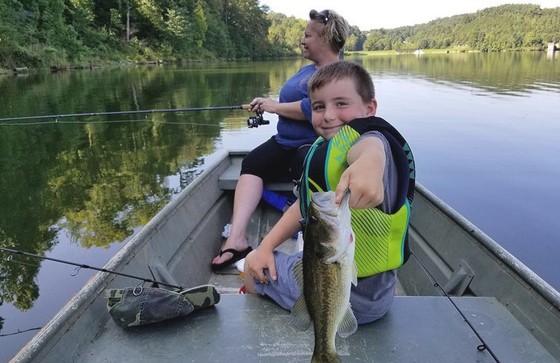 Make a memory: Take advantage of Georgia's free-fishing Saturdays.
National Fishing and Boating Week June 1-9 offers free fishing Saturdays – no license needed in Georgia June 1 and 8 – and a statewide lineup of kids fishing events. Find an event and fishing hotspots (plus how-to tips).
Proposed rules for the Georgia Outdoor Stewardship Program have been published and a public meeting set for 6:30 p.m. May 30 at Panola Mountain State Park. Comments on the rules, key to the new grants program offering dedicated funding for parks, trails and acquiring wildlife lands, are due by June 21.
Names in the news: The Georgia Conservancy has a new president. Bart Gobeil, previously senior director of economic development and state government affairs at the Georgia Ports Authority, will succeed the conservancy's interim president Jim Timmons and past president Robert Ramsay on June 3. Retired Auburn University professor Dr. Dan Speake died May 7 in Huntsville, Ala. His teaching and research spanned 40 years and provided key contributions involving bobwhite quail, wild turkeys and eastern indigo snakes, the latter including work at Alapaha River WMA. The U.S. Fish and Wildlife Service’s Dr. Michele Elmore will be one of five agency employees recognized as 2018 National Recovery Champions for the Southeast during the Endangered Species Day celebration at Atlanta Botanical Garden June 1. Elmore, who works at the Georgia Ecological Services Office, will be honored as part of the four-member eastern indigo reintroduction team, which created the agency’s first snake-rearing facility at Welaka National Fish Hatchery. The April issue of The Journal of Wildlife Management features a cover photograph of an American oystercatcher by DNR wildlife biologist Tim Keyes and a study that Keyes and fellow senior wildlife biologist Mark Dodd helped author on how sea level rise will effect coastal habitats. The Georgia Mountains Children’s Forest Network received the Trail Promotion and Education Award at the International Trails Symposium and Training Institute. The network is aimed at managing and supporting programs that connect north Georgia youth to the national forest.
Top
UPCOMING
June 1 – Endangered Species Day, 10 a.m.-2 p.m., Atlanta Botanical Garden
June 1-9 – National Fishing and Boating Week. Free fishing in Georgia June 1 and 9. Kids fishing events.
June 6 – North Georgia Prescribed Fire Council meeting, Chattahoochee Technical College, Jasper. Register by May 31.
WHAT YOU MISSED …
In the previous Georgia Wild:
- Cottonmouth encounter
- Best plant for black swallowtails
- Questions trail endangered whales
- Loons or gulls: Which finds the fish?
Top
"Loggerhead sea turtle nesting season begins on Georgia coast," Associated Press
"DNR: Be on lookout for Argentine tegu lizard," WTOC-TV (channel 11, Savannah)
"Three Colquitt County students among winners of wildlife art contest," The Moultrie Observer. Also: AllonGeorgia.
"Beachgoers urged to help protect nesting birds," The Albany Herald
"Scientists warn that humans threaten 1 million species with extinction," The Washington Post. Also: opinion article by National Wildlife Federation.
"House committee backs right whale conservation bill," The Brunswick News
"Snow crab industry gets $2 million to find ways to reduce right whale entanglements," Canadian Broadcasting Corp.
"Record, insights mark 14th DNR birding competition," The LaGrange Daily News
"Rare mountain bogs are 'gems' in Georgia," The Atlanta Journal-Constitution
(audio) "Pitcherplants: a world unto themselves," In Defense of Plants podcast
"U.S. 80 fix to consider wildlife, human life needs," Savannah Morning News
(+audio) "On the Flint, a fight for a fish," Georgia Public Broadcasting
"Science, sensationalism and lessons of ‘Insectageddon,'" Undark
"North Carolina bald cypresses among world’s oldest trees," Smithsonian.com
"Unusual family of bald eagles adds three eaglets," National Public Radio
"Why carbon credits for forest preservation may be worse than nothing," Pro Publica
"How a tiny endangered fish put a man in prison," High Country News
"Climate change and the new age of extinction," The New Yorker
Top
VIDEOS
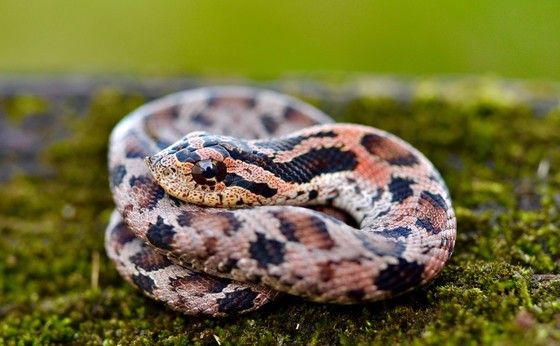 Juvenile eastern hognose snake (Mark Krist)
DNR senior wildlife biologist John Jensen and Public Affairs’ Heidi Ferguson have produced a series that walks Georgians through healthy perspectives on snakes. Watch "Snakes You Don't Know" (also on YouTube) and "Snakes in Your Backyard." Coming soon: a closer look at venomous snakes.
Other videos of note:
"The Sandhills," featuring a close look this unique community and including interviews with DNR biologists, Georgia Outdoors
“Ranger Nick Takes a Trip to the Mountains (to learn about endangered species),” including DNR’s Thomas Floyd, Georgia Farm Monitor
“Pollinator Garden,” a look at the Connect to Protect project at the Oconee County (Ga.) Veterans Park Senior Center with DNR’s Dr. Mincy Moffett Jr. and Anna Yellin, Oconee County. Also on Facebook.
“Going Batty at Black Rock Mountain,” with advice on excluding bats from buildings, DNR
“Osprey Chick Blurs Nest Camera with Perfect Shot,” The Landings (Savannah)
Top
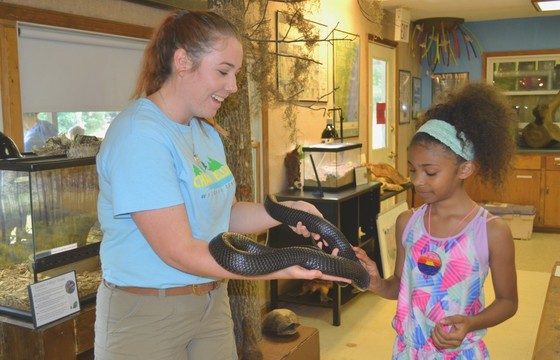 The annual Keeping Georgia Wild Festival drew a crowd to Charlie Elliott Wildlife Center near Mansfield Saturday. In addition to free admission and a hot dog lunch, participants enjoyed an array of wildlife- and outdoor-oriented activities, from getting up close with an eastern indigo snake in the center’s Brooke Ager Discovery Area (above) to getting their hands dirty planting at the Garden Club of Georgia booth (below). Sponsors included the Georgia Wildlife Federation, Fellowship of Christian Athletes Outdoors, National Wild Turkey Federation and DNR’s Wildlife Resources Division. More photos.
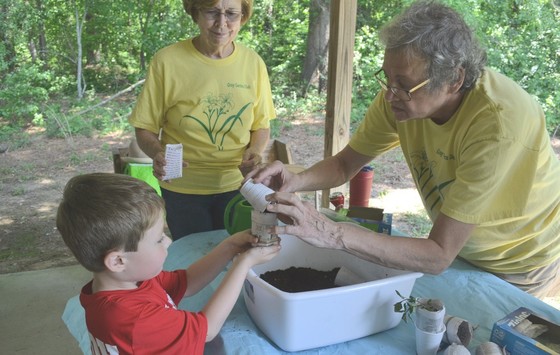
CREDITS
Masthead: DNR's Mark Dodd holds a diamondback terrapin (Rick Lavender/DNR)
Diamondback terrapins caught, assessed and released during a recent survey (Rick Lavender/DNR)
Top
|